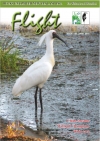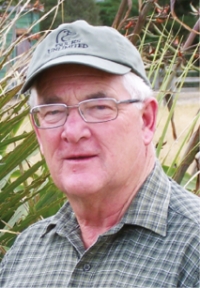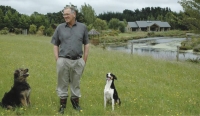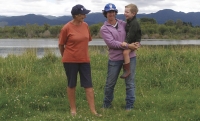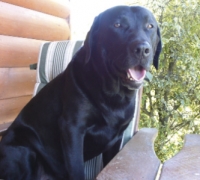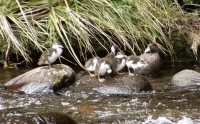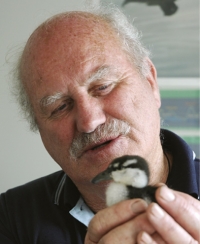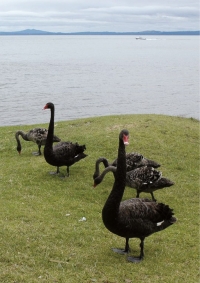The late spring - summer across most of New Zealand has been significantly wetter than last year and this is good for wetlands and waterfowl with greater survival of young birds. Although most of the large permanent lakes (Waihola, Ellesmere, Wairarapa, Hatuma and Whangape) still exist, many of them suffer from water quality problems which…
Published in
Issue 159
Tagged under
Planning is well underway for our AGM/ Conference at Brackenridge Country Retreat & Spa, Martinborough, Wairarapa, Friday August 1 to Sunday August 3. A three minute drive from the Martinborough Square, Brackenridge sits within view of the iconic Haurangi ranges. Reminiscent of early New Zealand station dwellings yet with welcoming stylish interiors, the cottages and …
Game bird hunters are probably all checking their equipment ready for the May 3 Saturday start to the hunting season. No 1 on the list should be the game bird hunting licence. Check your bank account, the full season licence has gone up one dollar. That’s right $91 this season. Why the extra dollar?…
Published in
Issue 159
Tagged under
Change attitudes and improve the environment The Mangaone West region is typical of many farming districts where remaining indigenous cover is very limited and the balance is in productive farmland. Into this area a few years ago stepped Ducks Unlimited member Ossie Latham, and his conscious was pricked by the degradation he saw in the waterways…
Published in
Issue 159
Tossi field day At the recent Volunteers Day at Tawharanui Regional Park, one of the tasks was to weed the new plants that had been put in last year beside the Bird Hide. The Lagoon at Jones Bay has been very busy now with various water bird life and they are not at all worried about…
Jim Coster has been farming Mataiwhetu Station for almost 60 years (his family purchased the property on his 21st birthday) and now his eldest son, Allen, manages operations. The farm was originally rundown with leaky fences, rudimentary sheep yards, a basic woolshed and no cattle yards. About a quarter of the 300ha was covered in fern and…
Published in
Issue 159
Tagged under
Combining good farming practices with proactive steps to look after the wetlands on their beef and dairy farm, has earned Ducks Unlimited members in the Wairarapa, Jane Donald and her family, the title of “National Rural Wetland Champion 2014”. To celebrate World Wetlands Day this year, the National Wetland Trust and the Department of Conservation…
Published in
Issue 159
Tagged under
Game bird hunters were invited this year to help farmers disperse big flocks of Paradise shelduck from paddocks and crops on private land in the Wellington region. The special three weekend hunting season starting from Saturday, February 8 took place in the Manawatu/Wairarapa areas. Fish & Game introduced the special season to assist landowners who have…
Published in
Issue 159
Tagged under
Lack of ducks – Where have all the mallards gone…? A Wairarapa Times Age article (March 3) regarding the dramatic drop in the number of ducks that can be hunted during the forthcoming season makes depressing reading! But lack of habitat and the impact of predators are certainly not the main reasons why our main gamebird…
Published in
Issue 159
Tagged under
Bird numbers up at Lake Ellesmere – annual census An “all wetland species” census of Lake Ellesmere was carried out on February 22 by 12 teams of observers: Ornithological Society NZ, Department of Conservation, Christchurch City Council rangers, Fish & Game, Environment Canterbury, Ngai Tahu, Rotoract, Waihora Ellesmere Trust, and others. There were 55,033 birds counted thanks to…
Published in
Issue 159
Tagged under
Pukaha Mt Bruce news Paintings at Pukaha It started in March but continues to June 22 so you can enjoy an exhibition of native bird paintings at Pukaha Mount Bruce. Entry to the exhibition is free of charge. Mauriora update In October 2013 Mauriora, the second white kiwi to be hatched at Pukaha Mount Bruce, was released into the…
Published in
Issue 159
Tagged under
The Whio Forever partnership is adding another tool to its arsenal of protection this year with funding to build a new whio rearing facility at the Tongariro National Trout Centre near Turangi. National Whio Recovery Group leader Andrew Glaser said the North Island whio rearing facility will help recover the national whio population by allowing whio…
A successful breeding season for whio included 16 juveniles that arrived safely in the North Island from Peacock Springs. They were collected from the airport by DU member and Palmerston North aviary keeper Peter Russell. Peter said that 33 captive birds have been bred this summer. “It’s also been the best season in the wild…
Eleven volunteers from the New Plymouth branch of PricewaterhouseCoopers spent a day out of the office as they helped replace over 90 stoat traps along the Curtis Falls Track in the Egmont National Park. The old traps came out of the boxes and new stainless steel ones went in. Replacing a line like this can…
Published in
Issue 159
Tagged under
Before the arrival of the Māori in New Zealand, a subspecies of the Black Swan known as the New Zealand Swan had developed in the islands, but was apparently hunted to extinction. In 1864, the Australian Black Swan was introduced to New Zealand as an ornamental waterfowl, and populations are now common on larger coastal or…
Published in
Issue 159
Tagged under
It could have lived here for 60 million years! Those Aussies are trying to steal our things again! There have been claims that the Kiwi actually originated in Australia. To make it even trickier it was a New Zealander, Trevor Worthy who’s involved with research at Flinders University in Adelaide, who put this theory forward.…

